1920 Major News Events in History
- January 16th Eighteenth Amendment Prohibition Begins
- August 18th Nineteenth Amendment To The Constitution ratified giving women the right to vote
- November 21st Irish Revolution Irish Revolution Bloody Sunday (Black and Tans) arrive in Dublin
- September 16th Wall Street Bombing
- January 2nd Palmer Raids
More Detailed Information on each Event and those not included can be found below
List of What Happened in 1920 Important News and Events, Key Technology, Prices & Popular Culture
1920 was the start Start of The Twenties Housing Boom, Russian Civil war Ends, First Red Scare and Palmer Raids, Irish Revolution, Wall Street Bombing, League of Nations, Mexican Revolution ends,
United States - 18th Amendment Passed - Prohibition Begins
Question : When was the 18th Amendment Passed and Prohibition Began ?
Answer : In the United States the Eighteenth Amendment to the Constitution is started in 1920, which outlawed the production and consumption of alcohol and was more commonly known as Prohibition.
More Information and Timeline For Eighteenth Amendment To The Constitution1. The Women's Christian Temperance Union marches on Washington D.C. on News Events From December 10 of 1913, asking the US government to create a prohibition amendment.
2. The US Senate proposes the 18th amendment to outlaw the production, transport and sale of alcohol.
3. The 18th amendment is ratified on January 16th of 1919, after being adopted by thirty six states.
4. Congress passes the Volstead Act (National Prohibition Act) on October 28, 1919, which establishes the definition of illegal liquor and the punishments for making it.
5. The 18th amendment goes into effect on January 16th,
6. From the beginning of prohibition until it is repealed, organized crime increases as violent gangs produce and transport black market alcohol that is sold in speakeasies.
7. President Franklin Roosevelt signs the Cullen-Harrison Act on March 22nd of 1933, which legalizes some alcohol.
8. The 21st amendment is ratified on December 5th, 1933 and repeals the 18th amendment and effectively ends prohibition.
Part of 1920 Fashions
Twenties Dainty Dress Up Frock
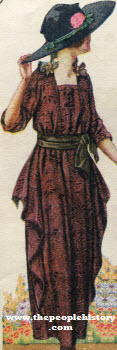 Dainty Dress Up Frock
Dainty Dress Up FrockPrice: $15.49
20's style Dainty dress-up frock of beautifully patterned richly colored silk and cotton crepe with the appearance of silk georgette. Waist blouses over a soft, gray silk taffeta ribbon girdle with side bow, and shows taffeta ribbon ruche and gilt braid at neck. Side-draped skirt.
Part of 1920 Accessories
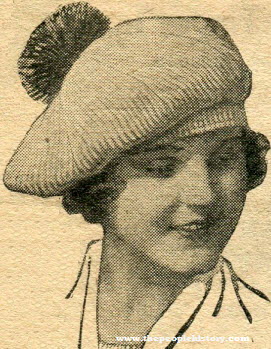 Ladies Corduroy Tam
Ladies Corduroy TamPrice 98 cents
Very fine quality Corduroy Tam. Made full and trimmed with large straw pompon. Suitable for misses and children. Colors come in rose, blue, or white.
UK - Start of The Twenties Housing Boom
The war in Europe was over but politicians realized that many men who were coming home after the war would not have homes to go to and Britain was one of the countries that tried to address this by announcing it would build 1,000,000 homes for war veterans.
More Information and Timeline For 1920's Housing Boom
1. World War I ended in 1918, world leaders realized returning soldiers needed homes
2. In England British Prime Minister Lloyd George called for Homes fit for heroes to be built, The British Ministry of Health published The Housing Manual which contained a pattern of simple housing designs together with lax planning laws, cheap land and low deposits ( £50 deposit ) on a £850 home created large new housing estates across the UK.
3. In the United States increased home construction centered mostly on a few key areas Florida and Chicago both saw large numbers of new homes built, other parts of the country also saw increased construction, reasons were many men coming home from war needing homes and with low interest rates and a weakening of banking supervision leading to Financial innovation which meant loans were made with less oversite.
4. By the late 20's in the U.S. ( 1926 and 1927 ) the housing bubble caused by the large scale home building and low interest rates caused the housing market to collapse in the U.S. and although not thought to be the direct cause of The Great Depression is thought to have had some impact.
U.S.A. -- Nineteenth Amendment To The Constitution ratified
Nineteenth Amendment To The Constitution ratified on August 18, giving women the right to vote.
More Information and Timeline For Nineteenth Amendment To The Constitution
1. The Nineteenth Amendment's text was drafted by Susan B. Anthony with the assistance of Elizabeth Cady Stanton and was first introduced in 1878.
2. The women's suffrage movement pressed for its inclusion for nearly 40 years with little success.
3. Following President Woodrow Wilson making a strong and widely published appeal to Congress to pass the amendment it passed on May 21, 1919.
4. The Nineteenth Amendment to the Constitution was ratified on August 18 .
5. Women voted for the first time during the general elections.
Raggedy Ann and Raggedy Andy Doll History
Raggedy Ann ( is a rag doll with red yarn for hair and has a triangle nose ) started as a character created in his books by American writer Johnny Gruelle about 1915, he also was far ahead of the times and filed for a patent, the doll was marketed with the book and were originally handmade, he introduced Raggedy Andy in 1920 with the Raggedy Andy Stories which introduced Raggedy Ann to Raggedy Andy.
Over the years the dolls were made by a number of manufacturers, the current dolls are made by Aurora World
You can still buy new Raggedy Ann and Raggedy Andy dolls today which have hardly changed and are still popular with today's children 100 years later
USA -- Holland Tunnel Funds
The creation of the Holland Tunnel begins in October when funds were allotted to the project that would allow motor vehicle traffic to travel between New Jersey and New York City. The tunnel consisted of two tunnels each with two lanes and was constructed under the Hudson River. The project was overseen by and named after chief engineer Clifford Milburn Holland, who died during the construction. The feat of engineering was the longest underwater tunnel in the world at the time of its completion at about 2.55 miles long. Its completion was particularly notable for the innovative ventilation system that was developed.
Part of Twenties Cars
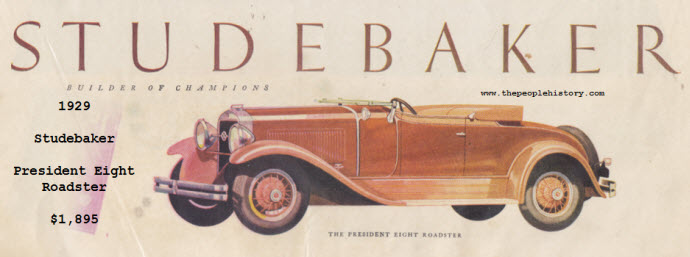 Studebaker 1929 President Eight Roadster
Studebaker 1929 President Eight RoadsterPrice From $1,589 to $1,895
Studebaker 1929 President Eight Roadster seats two in the comfortable front seats and two in the Rumble, 115 Horsepower engine, hydraulic shock absorbers, wire wheels, spare tire and bumpers are additional to the price.
Part of 1920s Appliances
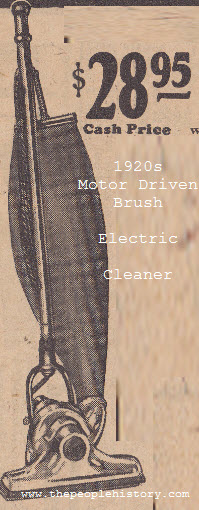
Motor Driven Brush and Suction Cleaner
Price: $28.95This cleaner not only uses suction to lift the dirt and dust it also includes a motor driven brush to help remove dust and dirt from the carpet before the suction lifts the dirt into the bag
Technology
The Ford Model T was continuing to sell well in the US.
Austin in the UK produced an Austin 20/4.
Airlines are starting to appear around the world as the commercial implications are realized, the start of what is now QANTAS in Australia, and KLM in Holland to name just two.
The first commercial radio stationtransmits on on August 20 in the United States, 8MK (WWJ), begins operations in
Detroit, Michigan. The first radios start to appear for sale in shops in the US.
Inventions, Inventors and Country (or attributed to First Use)
Sticky Plasters USA by Earle Dickson
Hair Dryer Germany
The Tea Bag by Joseph Krieger
Parachute USA by Karl O.K. Osterday
U.S.A. -- League of Women Voters
In February Carrie Chapman Catt founded the League of Women Voters during the National American Woman Suffrage Association convention in Chicago, Illinois. Women were given the right to vote six months later after the nineteenth amendment was added to the U.S. Constitution. The non-partisan organization was created in an effort to encourage women to become heavily involved in creating, discussing, and influencing public policy as a way to fully embrace and take advantage of their newly attained voting rights. The League of Women Voters is still a functioning organization today and continues its grassroots history by calling for all women to participate in the political discussion and use their vote.
Russia -- Russian Civil war Ends - Famine Begins
More Information and Timeline for Russian Civil War
1. Nicholas II is crowned Tsar of Russia in May of 1896.
2. The Socialist Revolutionary Party is founded in 1901.
3. A small revolution begins with a strike in St. Petersburg. Peaceful protesters go to the Winter Palace to give the Tsar a petition and the Imperial Guard fires on the crowd, killing two-hundred people on January 9th, 1905.
4. Tsar Nicholas II implements a few reforms like the creation of the State Duma.
5. Russia joins the fighting during World War I in 1914.
6. Demonstrations begin during the February Revolution of 1917 and Nicholas II abdicates after the Duma defies his orders to dissolve and instead creates a provisional government.
7. The Red Army is created during the October Revolution of 1917 and the All Russian Congress of Soviets chooses Lenin as their leader, after the Bolsheviks overthrow the provisional government.
8. The White Army begins their fight against the Communists at the end of 1917, marking the beginning of the Russian Civil War.
9. The Russian Constitution of 1918 is established and creates the Russian Socialist Federative Soviet Republic. Lenin orders the execution of the Tsar and his family and the Red Army begins massive expansions in 1918.
10. A unified anti-Bolshevik government is created in September of 1918 and is called the Ufa Directorate, it is overthrown in November of that year.
11. The Red Army and Soviet Russia continue to expand and encourage the territories surrounding Russia to become communist, supporting their revolutions.
12. The White Movement loses widespread support as the Red Army continues to gain ground and the White Army's commander, Pyotr Wrangel, flees Russia, marking the end of the Russian Civil War. There were an estimated three million lives lost due to fighting, disease and famine during that period.
13. Famine strikes the Soviet Union immediately after the end of the civil war, killing an estimated five million or more people.
United States -- First Red Scare and Palmer Raids
In the wake of World War I and the Russian Revolution, many became afraid of the influence of communism in the world and within the United States that fear was acted out during the "First Red Scare." During this period of time, alleged communists and radicals were targeted by law enforcement, specifically under the direction of the U.S. Attorney General, A. Mitchell Palmer. While there were legitimate concerns surrounding violent strikes and bombing attacks made by anarchists, the actions which were used against the accused had questionable constitutionality. Public opinion initially favored Palmer's pursuits but after several threats that he had warned against failed to materialize, public opinion shifted against Palmer and his actions were viewed as an overreaction to what looked like an imagined threat. The 1919/1920 Palmer Raids were the most extreme culmination of actions during the "First Red Scare" which took place between about 1917 to the middle of the year.
Below we have included a more detailed timeline with events contributing to and surrounding this moment in history.
1. April 6th, 1917 - The United States enters World War I after declaring war on Germany.
2. June 15, 1917 - The Espionage Act is passed by the U.S. Congress, creating harsh penalties for anyone found to be interfering with the United States war efforts through the sharing of information to the country's enemies.
3. October of 1917 - The Russian Revolution ends with Bolshevik communists taking power.
4. May 16, 1918 - The Sedition Act is passed by the U.S. Congress, creating more harsh penalties aimed at people who were against American participation in World War I. The law punished dissenters including anyone who was found to be insulting the government. The Sedition Act is considered by many law scholars to be in direct conflict with the First Amendment right to free speech.
5. November 11, 1918 - World War I ends.
6. 1919 - Three large strikes take place across the U.S.
7. March 5, 1919 - A. Mitchell Palmer is appointed as the Attorney General by President Woodrow Wilson.
8. April of 1919 - Anarchists mail 36 bombs to politicians across the United States, most are intercepted but a few cause damage and injuries.
9. June 2, 1919 - The home of Attorney General A. Mitchell Palmer is bombed by Carlo Valdinoci, an anarchist, in Washington D.C. Anarchists also plant bombs in several cities across the U.S.
10. Palmer appoints J. Edgar Hoover as head of the General Intelligence Division in the Justice Department to gather intelligence and organize a series of raids against alleged anarchists, communists, and leftists.
11. November 2, 1919 - 200 people are arrested in a raid on the Union of Russian Workers.
12. November 25, 1919 - Palmer conducts a second raid on the Union of Russian Workers.
13. December 21, 1919 - Over 200 people are deported to Russia on the USS Buford. The ship was nicknamed the "Soviet Ark."
14. Palmer begins planning a larger raid than before after being convinced that there was a Bolshevik conspiracy to overthrow the U.S. government.
15. January 2nd, 1920 - Thousands of people are arrested across more than 30 cities in the United States in a coordinated effort between police and the Justice Department during the largest of the Palmer Raids.
16. Many of the arrests that were made in the raids were done without regards to constitutional protections of free speech and from illegal searches and seizures. As Palmer used the Espionage and Sedition Acts to pursue many of his targets, he was able to circumvent the potential illegality of the raids.
17. The ACLU (American Civil Liberties Union) was created and documented the Palmer Raids, making an effort to fight against the deportations and unlawful arrests made during the period.
18. Palmer sent many of those arrested to the Bureau of Immigration for deportation. The Assistant U.S. Secretary of Labor, Louis Freeland Post, who oversaw the department, disagreed with Palmer's actions and assessments related to the "Red Scare" and reversed a majority of the deportation orders he had received.
19. Palmer continued to talk of the public threat of radicals and predicted a large attack on the U.S. government to take place on May Day in 1920. When the holiday came and passed without any incident, Palmer's credibility was put into question and the First Red Scare came to an end.
20. March 4, 1921 - A. Mitchell Palmer retires and is replaced by Harry M. Daugherty as the U.S. Attorney General after Warren G. Harding becomes the U.S. President.
21. J. Edgar Hoover would continue to hunt for radical leftists in the U.S. as he later became the Director of the FBI. He was a leading figure in the "Second Red Scare" between the late Thirties and 1950s.
Hungary - Treaty of Trianon is signed between the Allies and Hungary
The Treaty of Trianon is signed between the Allies and Hungary, ending World War I between the two sides.
The Treaty of Trianon was signed in June This Year. The treaty laid out the formal terms of peace between the Allied powers on one side and the newly created Kingdom of Hungary on the other. Some of the objectives of the treaty included defining the borders of Hungary in addition to establishing its independence. The treaty was signed at the Trianon Palace in Versailles, France. Although the war had technically ended in 1918, the Allied powers had been reluctant to make peace with Hungary until a more stable government was put in place. Hungary was able to establish a more stable government , prompting the peace deal.
Belgium - Summer Olympics
The Summer Olympics are held in Antwerp, Belgium.
During April the Summer Olympics were held in Antwerp, Belgium. The theme of these games was remembering the victims of the First World War and reconciliation between nations after the end of the war. These were the first games in which the Olympic flag and symbol of five interlocking rings appeared and they were used to represent unity and universality after the war. These were also the first games in which doves were released in the opening ceremony to symbolize world peace. The United States, Sweden, and Great Britain came away from these games with the highest total medal counts overall, with 95, 64, and 43 respectively.
Ireland - (Black and Tans) arrive in Dublin
More Information for the Royal Irish Constabulary.
In March the first of the Royal Irish Constabulary, also known as the Black and Tans, arrived in Dublin. The RIC was a group created by the British government and was sent to Ireland to police the Irish, bolster other British forces, and fight against the Irish Republican Army during the Irish War of Independence. The group consisted of thousands of hastily trained men, many of whom had been unemployed World War I veterans. Due to the lack of training and discipline within the Black and Tans, they gained a reputation for brutality and had staged many retaliatory attacks and crimes against the Irish civilian population. The group was disbanded in 1922.
Ireland - Irish Revolution
Irish Revolution Bloody Sunday
During the Irish Revolution on November 21st Bloody Sunday left more than 31 people were killed including fourteen British, fourteen Irish civilians and three republican prisoners, An Irish Republican Army (IRA) operation assassinates the Cairo Gang a team of undercover agents working and living in Dublin including 12 British Army officers, one a member of the Royal Irish Constabulary and the last a civilian informant, In Retaliation The Royal Irish Constabulary opened fire on the crowd at a Gaelic football match in Croke Park, killing fourteen civilians. On December 10th Martial law is declared in Counties Cork, Kerry, Limerick and Tipperary. Following increasing violence the Government of Ireland Act of 1920 is passed by the Parliament of the United Kingdom, receives Royal Assent from George V providing for the partition of Ireland into Northern Ireland and Southern Ireland with separate parliaments, granting a measure of home rule
Calendar For The Year 1920
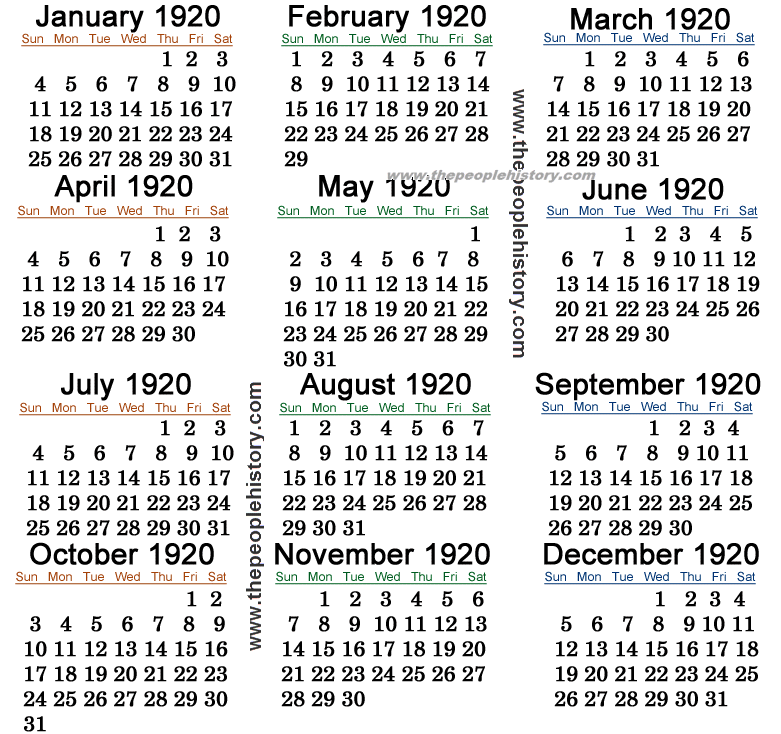
Ireland - Northern Ireland Created
The Government of Ireland Act creates Northern Ireland.
1. The Government of Ireland Act is given royal approval by King George V in December .
2. The act created the borders for Northern and Southern Ireland and proposed the creation of separate parliaments for each region.
3. It also indicated that the two regions would remain a part of the United Kingdom.
4. Northern Ireland accepted the act but Southern Ireland rejected it and continued to fight and negotiate with England.
5. England and the Southern parts of Ireland eventually agreed to a truce in July of 1921 .
6. By December of 1921 they signed the Anglo-Irish Treaty which removed British rule from Ireland.
7. The Irish Free State was created in December of 1922.
8. The Act continued to be used for Northern Ireland until 1972 when some of it was suspended.
9. Any remaining ties to the Government of Ireland Act ended in 1998 with its repeal and replacement by the Good Friday Act.
USSR - Soviet Union and Georgia sign the Moscow Peace Treaty
During May , the Soviet Union and the newly independent nation of Georgia signed the Moscow Peace Treaty. The treaty was important in that it formalized the USSR's recognition of Georgia's independence, defined borders between the two nations, and established a baseline for diplomatic relations between the USSR and Georgia. The treaty went far in establishing Georgia but it also made sure that the Soviet Union still had a firm grasp on politics and Communist ideology in the region.
Mexico - Pancho Villa Surrendered and Mexican Revolution Ends
Pancho Villa surrenders to the Mexican government.
Mexican revolutionary and military leader Pancho Villa surrendered in July after reaching a peace agreement with interim Mexican President Adolfo de la Huerta, effectively ending the Mexican Revolution. Villa had been a part of the revolution from the beginning, emerging as one of the strongest revolutionary military leaders. Villa became one of the revolution's most recognizable figures as he led his own army known as the "Division del Norte," which continued guerilla warfare against the Mexican government until Villa's rival and the country's then leader Venustiano Carranza was removed from power and assassinated. Villa was eventually pardoned and retired from fighting, only to be assassinated in 1923 by his rivals.
U.S.A. -- Wall Street BombingRadical anarchists bomb Wall Street killing 38. .
World -- InfluenzaInfluenza (the flu) and pneumonia spread Worldwide killing many thousands. .
France -- League of NationsThe League of Nations comes into being in Paris and the US Senate votes against joining. .
Canada -- MountiesThe Royal Canadian Mounted Police Force is established after merging the Royal Northwest Mounted Police and the Dominion Police. .
France -- Prix de l'Arc de TriompheThe first Prix de l'Arc de Triomphe horse race is run on October 3rd
UK -- Tomb of The Unknown WarriorOn November 11th The Tomb of The Unknown Warrior is buried in Westminster Abbey, London, signifying the soldiers killed during World War I who were not identified. It is the first example of a Tomb of the Unknown Soldier.
Mexico -- Mexican Revolution endsAfter a decade of fighting the Mexican Revolution ends
U.S. -- The Human Fly ArrestedGeorge Polley "The Human Fly" is arrested on the 30th Floor while trying to climb up the outside of the Woolworth Building in New York before he reached the top (57th )floor on January 9th.
U.S. -- United States Railroad AdministrationThe United States Railroad Administration created during World War I in 1917 to ensure the quick and efficient movement of arms and men needed to support the war returns control of American railroads to its constituent railroad companies
U.S. -- TornadoesTornadoes swept through the mid-western and southern portions of the United States, killing more than 200.
Born This Year
Arthur Hailey - - April 5th
Isaac Asimov - - January 2nd
Walter Matthau - - October 1st
P D James - - August 3
Major World Political Leaders
Australia - - Prime Minister - - Billy Hughes - -
Brazil - - President - - Epitácio Pessoa - -
Canada - - Prime Minister - - Sir Robert Borden - - until July 10th
Canada - - Prime Minister - - Arthur Meighen - - From July 10
Italy - - Prime Minister - - Francesco Saverio Nitti - - until June 15th
Italy - - Prime Minister - - Giovanni Giolitti - - From 15 June
Japan - - Prime Minister - - Takashi Hara - -
Mexico - - President - - Adolfo de la Huerta - - From June 1st
Mexico - - President - - Adolfo de la Huerta - - until November 30th
Mexico - - President - - Álvaro Obregón - - From 1 December
Russia / Soviet Union - - Chairman of the Council of People's Commissars Vladimir Lenin
South Africa - - Prime Minister - - Field Marshal Jan Christiaan Smuts - -
United States - - President - - Woodrow Wilson - -
United Kingdom - - Prime Minister - - David Lloyd George - -